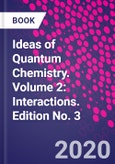Ideas of Quantum Chemistry, Volume Two: Interactions highlights the motions and systems in quantum chemistry and the models and tools used to assess them, thus giving detailed insights into the behaviors underlying quantum chemistry. Using an innovative structure to show the logical relationships between different topics, systems and methods, it answers questions and emphasizes knowledge using practical examples. Beginning with a review of the orbital model of electronic motion in periodic systems, the book goes on to explore the correlation of electronic motions, density functional theory (DFT), electric and magnetic fields, intermolecular interactions, chemical reactions and information processing.
This third release has been updated and revised to cover the latest developments in the field. It can be used on its own as a guide to key interactions and tools or in combination with Volume Two to give a complete overview of the field.
Please Note: This is an On Demand product, delivery may take up to 11 working days after payment has been received.
Table of Contents
1. Orbital Model of Electronic Motion in Periodic Systems2. Correlation of the Electronic Motions
3. Chasing Correlation Dragon: Density Functional Theory (DFT)
4. The Molecule Subject to the Electric or Magnetic Field
5. Intermolecular Interactions
6. Chemical Reactions
7. Information Processing The Mission of Chemistry








